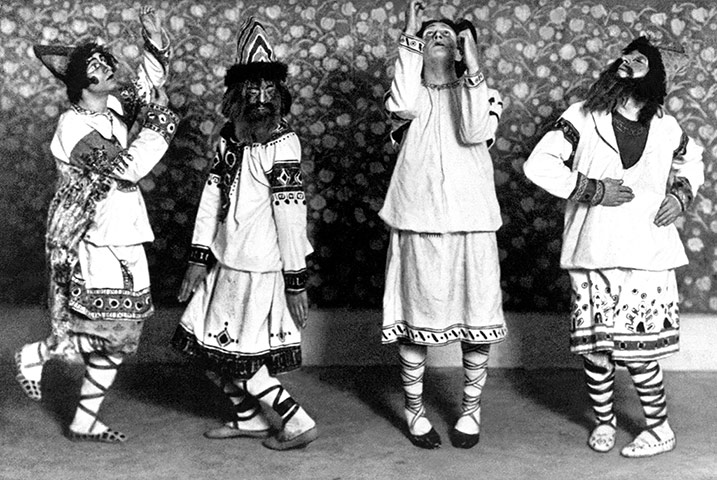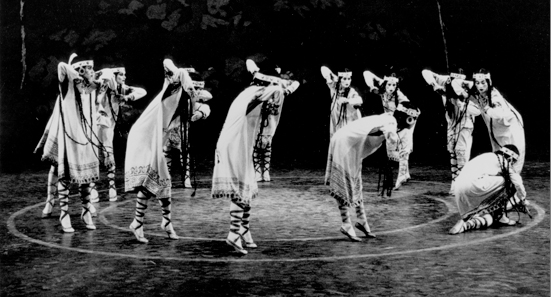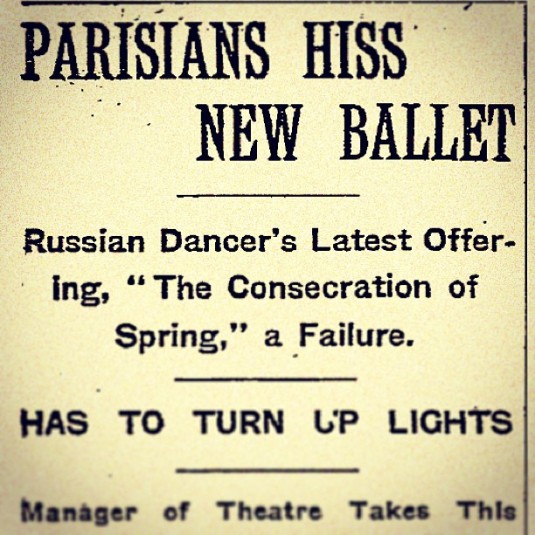 At the end of the Belle Époque, art produced a riot. The confluence of music and dance at the premiere of Igor Stravinsky’s The Rite of Spring caused an incensed audience to throw fists at each other and objects at the orchestra.
At the end of the Belle Époque, art produced a riot. The confluence of music and dance at the premiere of Igor Stravinsky’s The Rite of Spring caused an incensed audience to throw fists at each other and objects at the orchestra.
On May 29, 1913, patrons of the arts at the Théâtre des Champs-Élysées in Paris had little reason to expect an avant-garde production. The grand theatre opened on April 2 of that year. The Ballets Russes inaugurated its first season. Stravinsky found success composing for the ballet Petrushka in 1911. There may have been a prelude of things to come. Choreographer Vaslav Nijinsky had courted controversy with the eroticism of Debussy’s L’Après-midi d’un faune (The Afternoon of a Faun).
 Subtitled Pictures of Pagan Russia In Two Parts, The Rite of Spring was split into L’Adoration de la Terre (Adoration of the Earth) and Le Sacrifice (The Sacrifice). The first part features dancing that welcomes spring. In the second part, young women walk in circles and the Chosen One is selected to dance her to death as a ritual sacrifice. Stravinsky’s opening bassoon was inspired by Lithuanian folk songs.
Subtitled Pictures of Pagan Russia In Two Parts, The Rite of Spring was split into L’Adoration de la Terre (Adoration of the Earth) and Le Sacrifice (The Sacrifice). The first part features dancing that welcomes spring. In the second part, young women walk in circles and the Chosen One is selected to dance her to death as a ritual sacrifice. Stravinsky’s opening bassoon was inspired by Lithuanian folk songs.
The bassoon inspired the audience to boo. It introduced a dissonance and atonality to which they were not accustomed. Nijinsky’s choreography avoided conventional ballet grace, favoring angular movements and poses. Whereas other ballets would glide through the air, this one was rooted to the ground.
Boos turned into fisticuffs. Journalist Carl Van Vechten claimed that the person behind him drummed on his head. Conductor Pierre Monteux recalled, “many a gentleman’s shiny top hat or soft fedora was ignominiously pulled down by an opponent over his eyes and ears, and canes were brandished like menacing implements of combat all over the theatre.” Forty of the worst offenders were removed, possibly by police.
 Despite the inauspicious debut, it became one of the most enduring pieces of 20th century compositions. Twenty-seven years later, it was used in Disney’s Fantasia. It influenced composers Edgar Varèse, Aaron Copland and Olivier Messiaen. On September 30, 1987, the Joffrey Ballet recreated the original choreography.
Despite the inauspicious debut, it became one of the most enduring pieces of 20th century compositions. Twenty-seven years later, it was used in Disney’s Fantasia. It influenced composers Edgar Varèse, Aaron Copland and Olivier Messiaen. On September 30, 1987, the Joffrey Ballet recreated the original choreography.
The Rite of Spring mined the pagan past and forged a new path for modern composition.

There are no voices yet... Post-script us a message below, won't you?